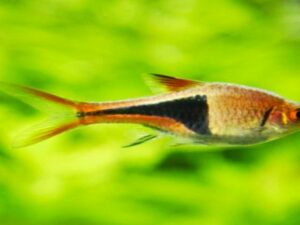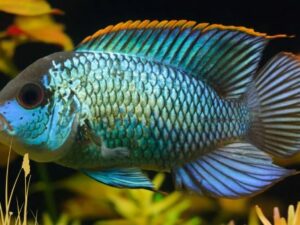Jaguar Cichlids are large species of Cichlids native to the Central America region. The Jaguar Cichlid is often referred to as the “managuense,” but this would be false since the scientific name for these fish is “Parachromis managuensis.”
They are known for their strength and thick jaw structure, and they received their common name from, Jaguars (strong, powerful jaws). But don’t let their looks fool you. Although they may appear violent at first look, not all Jaguars go around smashing anything that moves.
There are types of Jaguars that do much better in a community tank. Jaguars are highly territorial and will protect their area from any kind of fish that threatens it. If you plan on housing your Jaguar with other fish, make sure they are big enough to hold their own or simply just get one Jaguar per tank (if it’s a small tank).
These fish are powerful swimmers and need plenty of open space to swim around. Don’t be surprised if your Jaguar spends its time away from the bottom of the tank, and they enjoy exploring and swimming all around the tank.
This article will take a closer look at the Jaguar Cichlid. We will go over the proper tank requirements, water parameters, and diet, and finally, we will discuss some of the more common health problems that arise from improper care.
Table of Contents
- Species Summary
- Jaguar Cichlids Care
- Jaguar Cichlid Tank Size
- Water Parameter
- Water Changes
- Food & Diet
- Feeding Methods
- Jaguar Cichlid Tank Mates
- Cleaning The Tank
- Transportation
- Acclimation
- Ammonia Levels
- Nitrates & Nitrites
- Aquarium Decorations
- Lighting & Heating
- Filtration
- Growing Up
- Population Control
- Common Potential Diseases
- Treatments & Medications
- Advantages Of Having Jaguar Cichlids In Your Tank
- Disadvantages Of Having Jaguar Cichlids In Your Tank
- Other General Information
- Conclusion
Species Summary
| Scientific name: | Parachromis managuensis |
| Common names: | Jaguar Cichlids, Managuense, Jaguar Fish |
| Origin: | Central America, where it is found from Honduras to Costa Rica |
| Other names: | Electric Blue Jaguar, Black Jaguar |
| Lifespan: | 15 years or more if properly cared |
| Size: | 12-16 inches and more extensive. |
| Water temperature: | 73°-82°F |
| Care level: | Difficult |
| Lighting: | Moderate |
| Intensity: | Medium to high |
| Tank size: | Minimum 70 gallons |
| Aggression: | Very territorial |
| Social Structure: | Dominant male, dominant female |
| Diet Type: | Carnivorous |
| Maintenance Issues: | Extremely hardy but need big tanks. |
| Troubleshooting: | This fish is highly aggressive and does not house small fish. |
The Jaguar Cichlid (Parachromis managuensis) is a large, predatory Central American Cichlid from the swamps of Nicaragua and Honduras, where it lives in both fresh and somewhat brackish water.
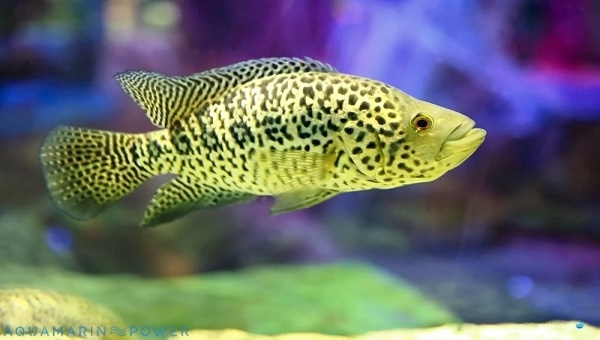
They are a member of the Cichlasoma group, which is a “catch-all” genus for many large South and Central American species. Due to its striking blue and black coloration, the Jaguar cichlid was previously known as the Electric Blue jaguar cichlid or Black jaguar cichlid. Today it is more commonly referred to as the Jaguar cichlid.
Appearance
The Jaguar Cichlid has a very distinctive look due to its large size, broad head, and dark bands on its body. These fish are typically black or bluish-black with irregularly shaped neon blue bands that are located from the dorsal fin to the gills. The dorsal, pelvic, and anal fins of this fish all have a yellow coloration with a black outline.
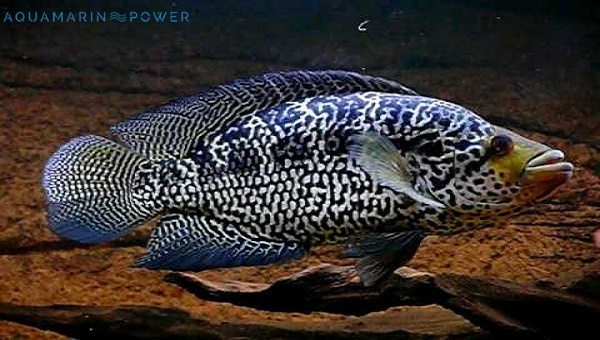
The Jaguar Cichlid has an elongated body, especially when viewed from above. They have a slightly rounded forehead with a concave shape to their head. Their eyes are located near the top of their head, enabling them to search for prey above the water’s surface.
The Jaguar Cichlid has a thick and broad lower jaw with conical-shaped teeth lining both the upper and lower jaws. The dorsal fin is located far back on its body, while the anal fin is situated closer to its caudal fin (tail).
When these fish are first purchased, they are typically a deep blue color. As time goes on, their colors can become dull, and they will develop more of a brownish-gold color to them.
Jaguar Cichlid Size
Jaguar Cichlids can grow to be quite large, with males reaching lengths of up to 16 inches (40.64 cm), while females typically grow to around 13 inches (33 cm). The maximum length for this fish is 24 inches (60.96 cm).
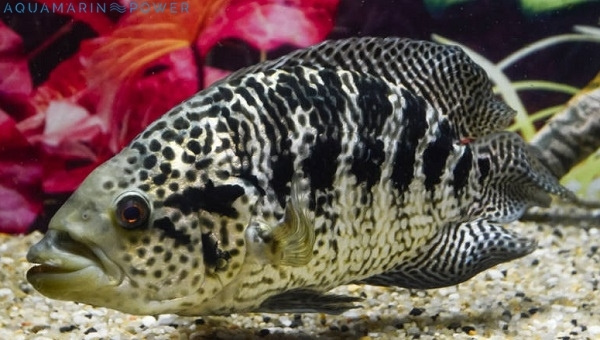
Jaguar Cichlid Origin and distribution
The Jaguar Cichlid is found in the swamps and shallow waters of Nicaragua, Honduras, and Costa Rica. They are also native to several rivers that drain into the Caribbean Sea, including the Rio San Juan.
In these waters, they tend to be found in areas where there is a lot of vegetation or other structures to provide cover. In the wild, they are predatory fish preying on various smaller freshwater fishes, crustaceans, and amphibians.
Jaguar Cichlid Lifespan
The Jaguar cichlid is a very hardy fish when compared to other Cichlids. It is known for adapting to almost any type of water conditions it is placed in, including murky waters with heavy vegetation.
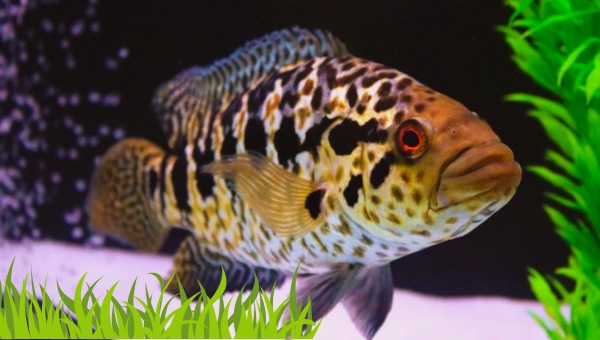
This species does well in captivity when provided with the proper environment and diet. Many aquarists have reported keeping these fish for ten years or more.
Jaguar Cichlid Behavior & Temperament
The Jaguar Cichlid is a territorial fish that will attack any other fish of the same species or size when they are in an aquarium. In their natural habitat, they are known to fight each other for territory. This can be very dangerous and painful for both parties involved.
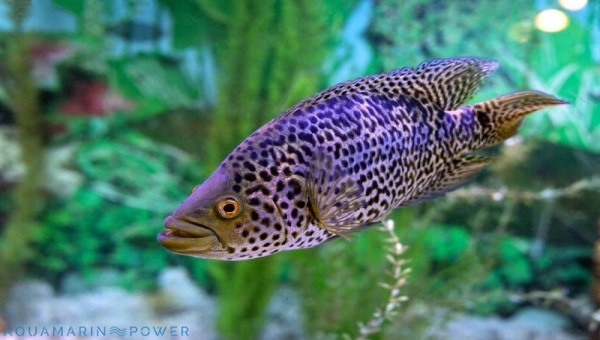
A possible way to solve this problem would be to keep only one of them in an aquarium. They can also be kept with other South American Cichlids as long as they are the same size and have similar aggressive tendencies.
Jaguar Cichlid Breeding
Jaguar Cichlids are much more difficult to breed in an aquarium than other types of Cichlids would be. They usually pick a favorite spawning location that they will protect until the eggs hatch. Jaguar Cichlids breed within rocks, caves, and tubes because these locations provide them with cover while they defend their young.
They will not allow any other fish within the vicinity of their eggs and will usually stay with them for about three to four weeks. When they get older, the parents will eventually chase their young away so they can breed again.
It is difficult to determine the sex of Jaguar cichlids because fins cannot distinguish them. The best way to tell their genders apart would be by looking at their color anCiCichliding.
It can also be determined by how they act over time and if they choose a specific area in an aquarium for spawning. Males tend to establish their territories within an aquarium, while females stay away from them.
Gestation Period & Young Ones
The gestation period for Jaguar Cichlids is about three to four weeks long. They usually breed during March and April. The number of young ones for this species range from five hundred to two thousand, depending on their size.
They will constantly guard their young until they are free swimming, about three weeks after they hatch from their eggs.
Jaguar Cichlids Care
It is essential to know the right kind of water conditions and temperature Jaguar cichlids prefer before getting them as a pet. Their housing should have a fine sand or gravel bottom, especially if they lay eggs within tubes or rocks to keep them from sinking into the substrate.
The tank should also have a sound filtration system because these fish create a lot of waste for their environment. You should also provide them with good lighting, but avoid putting the lights too close to the aquarium, so it does not get too warm.
Jaguar Cichlid Tank Size
A minimum of a 70-gallon tank is needed for this fish. Jaguar Cichlids need to be provided with ample swimming space and many hiding places. They will spend lots of time searching the room in the aquarium, so they must have ample rockwork and plants to provide adequate cover.
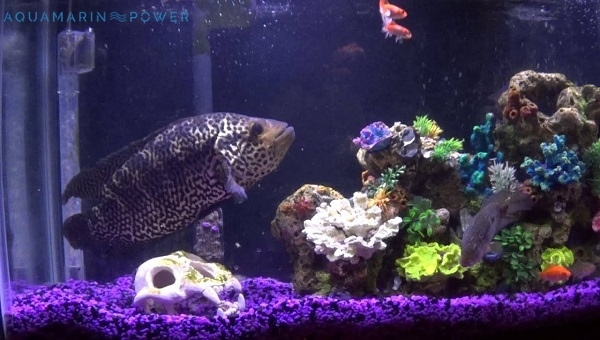
A tight-fitting lid must be used over the aquarium, as this species is known to have the ability to jump from great heights.
Water Parameter
Water quality must be maintained within the Jaguar Cichlid’s habitat to ensure dissolved oxygen levels stay high. Frequent water changes are necessary to remove waste products produced by these fish and other inhabitants in an aquarium.
- Water temperature between 73°-82°F.
- pH levels should range from 7.0 to 8.5.
- The gravity levels should be between 125 to 150 pounds per square inch (psi).
Water Changes
It is necessary to change the water in an aquarium that houses Jaguar Cichlids at least once a week. Water changes should consist of 25 percent while replacing the lost water with tap water or distilled water, which can be purchased at any pet store.
When changing the water, make sure the replacement water is within 3 degrees Celsius of their native water in the wild.
Food & Diet
The Jaguar Cichlid is a predatory fish, so it has a live prey diet. They will feed on smaller fishes, crustaceans, and amphibians in the wild. They are also known to eat mollusks in their native environment.
In captivity, this species of Cichlid should be given a diet that consists of live prey like feeder goldfish, feeder minnows (shiners), earthworms, etc. For prepared diets, they eat pelleted food, tablets, and flakes.
Jaguar Cichlids will eat constantly but can go for long periods without eating (up to one week). Feed them as much food as they can consume within five minutes each day.
Feeding Methods
Jaguar cichlids are aggressive eaters, so they must be fed in a separate tank that is filled with water. This will prevent them from eating their own or other fish’s food. The ideal method of feeding them is by using a turkey baster.
In captivity, they will eat from the top to the bottom of an aquarium. These fish are constantly looking for food and eat as much as they can in short periods. It is important not to overfeed them, or their digestive system may have problems processing all of the food they might consume.
Jaguar Cichlids should be fed in a separate tank filled with water. This prevents the fish from eating their own or other fish’s food. The ideal method of feeding them is using a turkey baster because it’s quick and easy while allowing you to control the amount of food that goes into each fish.
Jaguar Cichlid Tank Mates
Jaguars can be kept with other South American cichlids as long as they are the same size and have similar aggressive tendencies. They will also do well with non-aggressive fish such as catfish, loaches, and many species of tetras. Keep in mind that Cichlids should not be housed with any other fish.
Cleaning The Tank
You should never clean an aquarium with Jaguar Cichlids in it. These fish are predators, which means they can be very aggressive towards humans when they are around food. It is also necessary to remove uneaten food that might rot and pollute the water of an aquarium that houses this species of Cichlid.
All the decorations in the tank should be cleaned regularly. Gravel should not be replaced because it is where they spawn and prepare food. Only clean the tank when necessary using an aquarium vacuum that won’t harm them or their surroundings.
Transportation
Jaguar cichlids need to be transported in a plastic bag that is secure. The water pressure of an airplane or other transportation will hurt the fish if it enters the tank. In addition, the temperature must remain stable because these fish can’t survive if their temperature changes drastically.
Acclimation
It is essential to introduce a new Jaguar Cichlid slowly to a new tank. First, float the bag in the aquarium for 20 minutes so that the temperature inside of it can match that of the water surrounding it. After this time has passed, open the bag and use a fish net to transfer one-fourth of the previous tank water into a bucket for 10 minutes.
After 10 minutes, add one-fourth of the water from the bucket to the aquarium’s tank. Repeat this process for over 30 minutes until all of the fish has been transferred to its new home. Finally, add some food into the tank and spend plenty of time observing it so you can check for signs of stress or disease.
Ammonia Levels
The ideal ammonia levels for Jaguar Cichlids should be at 0 ppm because these fish are susceptible to it. Anything above .50 ppm can harm them, so you must maintain the water quality every day.
Nitrates & Nitrites
The ideal nitrate and nitrite levels for Jaguar Cichlids should be at 0 ppm. Anything above 5-10 ppm can harm them, so you must maintain the water quality every day.
Aquarium Decorations
A lot of live plants are beneficial for Jaguar Cichlids because they can provide them with shelter and retreats. These fish prefer to have many hiding places in their new habitats to feel safe. A piece of driftwood or a rock cave is beneficial for these fish because it will also shelter them.
You can add plastic or live plants into the aquarium to add a natural feel. Any decorations should be very sturdy, and sharp-edged decorations should be avoided with these fish. They do not need many plants or décor because they prefer to live in the open. You can add plants like Anubias and other hardy plants that will not be uprooted easily.
- Gravel Vacuuming: It is important to vacuum any uneaten food that has fallen into the substrate of an aquarium housing Jaguar Cichlids. Their mouths are shaped like suction cups, which means they can suck up food and take it away from other fish in their habitat. A good gravel vacuum is beneficial for these fish because it’ll prevent them from swallowing uneaten food and keep their tank clean.
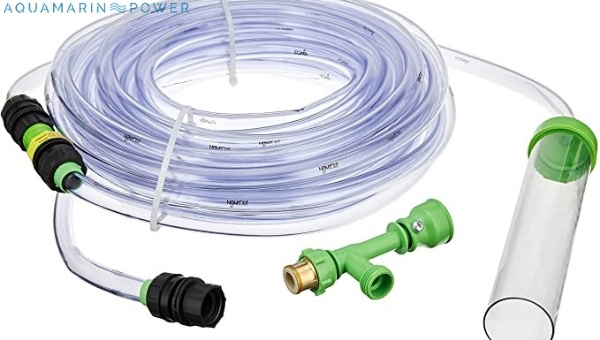
- Protein Skimmer: A protein skimmer is essential for any aquarium housing because it will remove all of the proteins and other particles in the water. These fish produce a lot of waste, which goes into the tank’s water over time. Without a protein skimmer, their water quality would become poor, and these fish wouldn’t be able to survive.
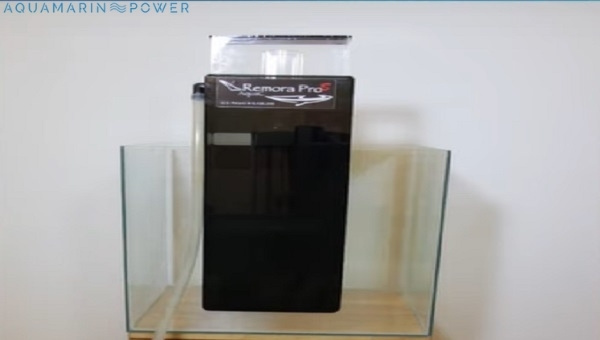
- Substrate & Gravel: A substrate of bioactive substrate is specifically beneficial for these fish. Tap water contains many harmful chemicals, so it’s important to let the water run through filter media first before using it.
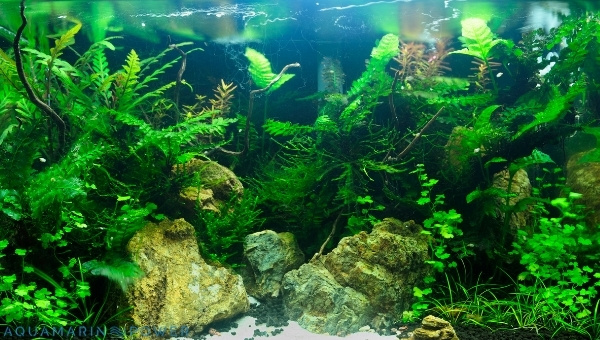
The best way to set up a substrate would be by filling half of an aquarium with pool filter sand and adding a vinyl tube or two as hiding places.
Lighting & Heating
Jaguar Cichlids are native to the tropics; therefore, they prefer water between 26-30 degrees Celsius. The best way to heat their tank would be to use a submersible heater in its center rather than placing them under rocks where they’re harder to maintain. A twenty-four-hour lighting cycle is necessary for these fish because they’re diurnal.
Filtration
Jaguar cichlids need to have a filter to keep their tank clean. The ideal substrate would be medium-grade gravel because it won’t scratch the skin of these Cichlids, which are very sensitive.
Growing Up
These fish are not fully mature until they are one year old. It can take up to three years for them to establish the coloration of their upper body. Males will usually lose the bottom portion of their coloration and focus on getting the upper half to be colorful.
Females are often plain in color with light yellow coloring, making it difficult to hide from other fish. They may also hide within plant pots or rocks if they feel like they’re not safe enough to come out. The babies eat algae and other small food items.
Population Control
The best way to control the population growth of Jaguar Cichlids is by separating them into different tanks. If you have a high population of these fish in one tank, it can lead to overcrowding and poor water conditions. You should avoid housing more than four adults in an aquarium because they may fight with one another.
Separating the sexes can help you control their population. Males will usually fight with other males, while females don’t pay much attention to each other. You can place them all in one tank and separate them according to their sex once they reach an age where their colors become visible.
Preventing the breeding of Jaguar cichlids is another way to control their population in an aquarium. You can keep them in too small tanks for them to breed, or you can allow them to mate and take care of their young ones until they are free-swimming.
Removing the eggs will help reduce any overcrowding in your aquarium. Only allowing them to breed once a year will help you control their population without having to move or separate them at all times.
Using the smallest adult size that you can find for an aquarium is another way to reduce the population size of Jaguar Cichlids. The larger the aquarium, the more fish you will be able to put into it, which means more fish that can breed.
Checking the tanks frequently for eggs or young ones is another way to control Jaguar Cichlid populations in an aquarium. It’s best to remove all eggs and young ones so they won’t become food for their parents. Using a large aquarium net is an excellent way to remove eggs or young ones from an aquarium.
Common Potential Diseases
Jaguar Cichlids are susceptible to ich and other parasitic diseases. They can get ich from live food that has not been adequately cooked beforehand or from another infected fish. Some signs of ich would be a lack of appetite, clamped fins, and a loss of coloration in the fish.
These symptoms will eventually lead to death if the fish does not receive treatment. Other signs of diseases or parasites would be redness around the eyes, white spots on the body, and difficulty breathing.
Jaguar Cichlids are also known to get ich from live food that is not cooked before consumption. If your fish is eating feeder minnows, make sure that they are properly cooked or frozen at -4 degrees Fahrenheit for at least 24 hours. This will ensure that the minnows are not carrying parasites into your aquarium.
Mercury can also be another risk factor with Jaguar Cichlids. It is advised to check local water supplies to see if mercury is present in the water. This Cichlid is usually sensitive to mercury poisoning, so make sure to research before getting one Cichlid fish.
Other diseases Cichlidn affect Jaguar Cichlids are holes in the head, cottonmouth, and acidosis. They will usually get these diseases due to inappropriate aquarium conditions or other fish already acquired them. These diseases can kill off an entire fish tank, so be careful when caring for Jaguar Cichlids.
Treatments & Medications
Some treatments for common fish diseases are copper, formalin, malachite green, methylene blue, and heat. Make sure to always follow the correct dosage when using medication in your aquarium. If you do not know the correct dosages, then look them up or ask an expert before putting them in your tank.
The most important medication to have in your fish tank is an antibiotic called Kanamycin Sulfate because it can treat hole in the head disease. This medication should only be used if necessary, though, so make sure to research all other medicines before using them in your aquarium.
Going back to treating ich, the best way to cure this common parasitic disease would be to quarantine the infected fish in a separate tank for about two weeks.
The main reason you would want to quarantine your fish is that this disease can spread very quickly throughout an aquarium, leading to mass casualties. Second, it is best to use methylene blue before using another medication because it will kill off any free-swimming parasites in the water.
Last but not least, you can also use formalin to treat parasitic diseases such as ich. Although formalin is used mostly for fin rot or fungus, it has been known to work on external protozoan infections that may attack your fish. It is recommended to follow the instructions carefully when using any type of medication in your aquarium.
Advantages Of Having Jaguar Cichlids In Your Tank
- Jaguar Cichlids are some of the most beautiful freshwater fish in the world.
- Many people like their personalities because they are always looking for attention from their owners.
- They will usually stare at you until you feed them or interact with them somehow.
- You can also easily differentiate him from her by looking at his pelvic fin, straight in males and curved in females.
- These Cichlids are perfect for beginners because they are very easy to take care of.
- They are very inexpensive, so it is perfect for those on a tight budget.
- These cichlids also help reduce algae growth in your tank by feeding off of it. This makes it easier to maintain your aquarium and keep your water clean simultaneously.
Disadvantages Of Having Jaguar Cichlids In Your Tank
- Be careful when housing jaguar fish with fish that are smaller than them because they may nip at their fins or eat them.
- These Cichlids are also known to go after newer additions to the tank, so you will have to make sure that you quarantine new fish and plants for at least a month.
- One more thing to be careful about is that jaguar cichlids can get very big, so make sure to have a large enough tank before purchasing one fish.
Other General Information
- Jaguar Cichlids are carnivores, so they should be fed flakes or pellets that have meat in them.
- Feed your Jaguar enough because these fish can grow very quickly if their diet is well-balanced. Jaguars are generally very easy to care for as long as their owners give them nutritious foods that meet their dietary needs.
- You should also know that jaguars are peaceful fish until they reach sexual maturity, and then they can become aggressive with other fish.
- These fish usually will not bother humans unless their owner disturbs them repeatedly.
- They also need a large aquarium because these cichlids are very active.
- This type of Cichlid is also diurnal, which means they are mainly active during the dayCichlidght.
- They do not usually know Cichlid active until about an hour after the lights go off in the tank.
- Jaguar Cichlids can be housed with other fish, but they should never be housed with fish that are smaller than them.
Conclusion
Overall, Jaguar Cichlids are one of the best fish to have in your aquarium. These creatures are straightforward to care for if their owners provide them with nutritious foods and give them plenty of space.
They also do not cause many problems, but they can get very aggressive once they mature sexually. The main disadvantages are how much space they need and how aggressive they are.
In the end, we can say that the Jaguar Cichlid is an outstanding freshwater fish that will bring life to any tank or aquarium. They are great for first-time owners because they are very inexpensive and can easily be taken care of.
Although they are not very difficult to maintain, it is still your duty to complete your research before purchasing one of these amazing creatures so that you can provide them with the best environment possible.


